The Shrink Label Machine Market is estimated to be valued at USD 586.2 million in 2025 and is projected to reach USD 876.0 million by 2035, registering a compound annual growth rate (CAGR) of 4.1% over the forecast period.
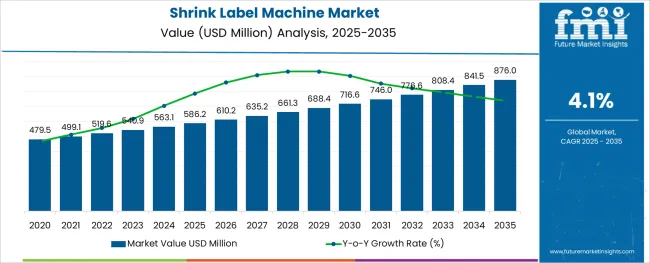
The shrink label machine market is experiencing steady growth as manufacturers increasingly prioritize operational efficiency, product differentiation, and compliance with evolving packaging standards. The rising demand for high-quality, tamper-evident, and visually appealing labels is motivating investments in advanced machinery capable of meeting diverse industry requirements.
Automation trends and heightened throughput needs are pushing adoption of machines that minimize manual intervention while maintaining precision. The market outlook is further supported by the proliferation of SKUs in retail and increasing investments by producers to optimize production lines.
Innovations in machine design, coupled with regulatory emphasis on packaging transparency and sustainability, are anticipated to drive continued expansion. Opportunities are being shaped by the convergence of faster labeling technologies, integration with digital control systems, and customization capabilities that cater to brand-specific needs, all paving the way for long-term market growth.
The market is segmented by Automation, Labelling Speed, and End Use and region. By Automation, the market is divided into Automatic and Semi-Automatic. In terms of Labelling Speed, the market is classified into 200 BPM to 400 BPM, Up to 200 BPM, 400 BPM to 600 BPM, and Above 600 BPM. Based on End Use, the market is segmented into Beverages, Food, Pharmaceutical, Chemical & Fertilizers, Cosmetics & Personal Care, Construction, Automotive, and Other Consumer Goods.
Regionally, the market is classified into North America, Latin America, Western Europe, Eastern Europe, Balkan & Baltic Countries, Russia & Belarus, Central Asia, East Asia, South Asia & Pacific, and the Middle East & Africa.
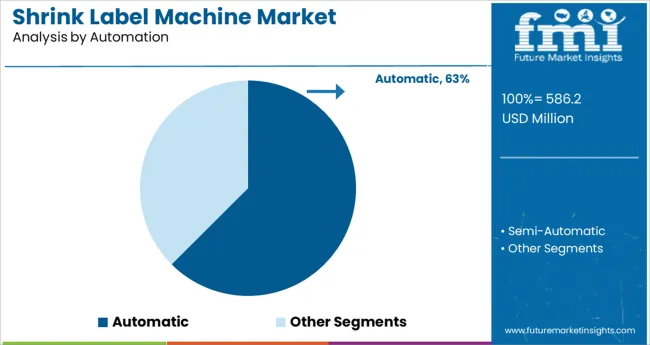
When segmented by automation, the automatic segment is projected to account for 62.5% of the market revenue in 2025, maintaining its lead among automation types. This dominance has been attributed to the growing necessity for uninterrupted, high-speed production lines that minimize human error and enhance overall productivity.
Automatic machines have been widely adopted as they reduce labor costs, improve consistency in application, and enable seamless integration into existing manufacturing setups. The ability to handle high-volume operations with precision and lower maintenance requirements has strengthened confidence among end users in adopting this segment.
Additionally, the scalability of automatic solutions and their compatibility with smart factory initiatives have further solidified their position as the preferred choice for modern production environments where efficiency and accuracy are paramount.
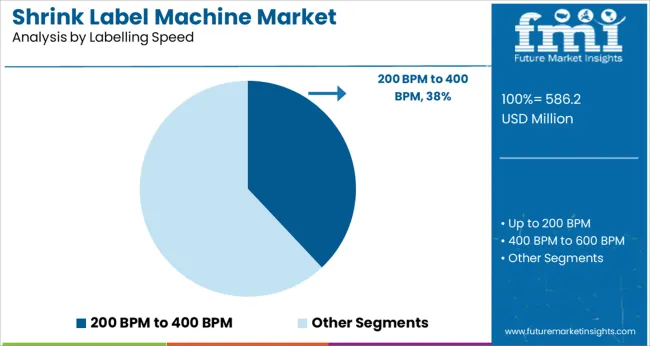
Segmented by labeling speed, the 200 BPM to 400 BPM segment is expected to capture 38.0% of the market revenue in 2025, establishing itself as the leading speed category. This prominence has been reinforced by its ability to balance high throughput with quality control, making it ideal for medium to large-scale production requirements.
Machines in this speed range have been preferred for their flexibility in adapting to diverse product sizes and packaging formats without compromising on label placement accuracy. The segment has also gained traction due to its suitability for industries aiming to optimize output while controlling operational costs.
Its leadership has been further supported by advancements in machine components and control systems that ensure stability at elevated speeds, making it a reliable option for manufacturers seeking efficient yet versatile solutions.
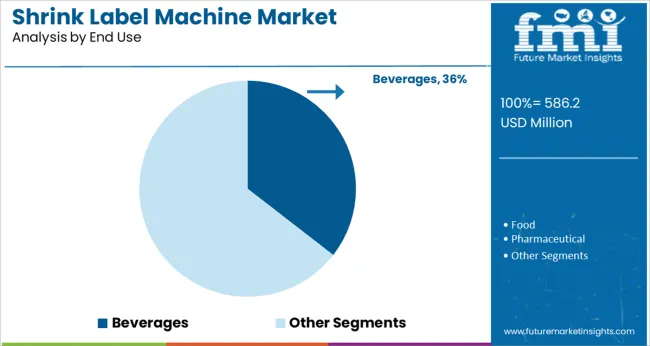
When segmented by end use, the beverages segment is forecast to hold 35.5% of the market revenue in 2025, retaining its leading position across industries. This leadership has been driven by the high volume and competitive nature of the beverage sector, which demands aesthetically appealing and tamper-evident packaging solutions.
Manufacturers in the beverages industry have increasingly adopted shrink label machines to differentiate products on crowded shelves and comply with stringent safety and labeling regulations. The segment has been further strengthened by rising consumer expectations for premium and customized packaging, which has encouraged brands to invest in machines that deliver superior label quality and flexibility.
Additionally, the beverages sector’s continual introduction of new product variants and flavors has amplified demand for versatile labeling solutions, ensuring the segment remains at the forefront of market growth.
The global shrink label machine market witnessed a CAGR of 3.6% during the historic period with a market value of USD 586.2 million in 2025.
The shrink label machine is becoming a priority for companies who are concerned with branding and advertising aspects. Big players in the packaging industry prefer to shrink label machinery over doing labeling by outsourcing. Over the past decade, companies have started labeling on their own. To avoid the barriers like miss-printing and others, companies prefer labeling along with the production of packaging solutions. Speedy manufacturing has always been a preferred choice of manufacturers. Speedy labeling production line helps the company to maintain the overall demand graphs and produce products accordingly.
The drastically changed Food industry amid the pandemic is projected to drive the demand for shrink-label markets. The changes in the eating habits and lifestyle of the people have increased the usage of labeled food which contains all the detailed information regarding the food product which creates a growth opportunity for the shrink label machine market. Overall, the global shrink-label machine market is anticipated to bolster at a faster pace during the forecast period.
Every industry needs product labels since they include the necessary information about the products. There are a number of standards and regulations pertaining to packaging and labeling, depending on the specific industry. For example, the food and beverage, pharmaceutical, medical, chemical, and fertilizer industries have stringent labeling regulations that specify product-specific labels, barcode standards for logistics and shipping bottles, containers, and more.
Fines may be assessed for failure to adhere to any of these rules and requirements. All manufacturers operating in the market are using labels for regulatory purposes as a result of these circumstances.
Along with this, manufacturers are automating more of their production, packing, and labeling operations. This is done to cut down on unnecessary labor costs. All these factors are likely to push the demand for Shrink label machines upward during the foreseeable future.
Based on the Automation Type segment, the automatic machine segment is estimated to remain the leading segment for the Shrink label machine market during the forecast period.
Many large-scale industries are adopting automated manufacturing as well as packaging systems for increasing output. The automatic Shrink label machine provides accuracy with a high productivity rate. It reduces labor demands and provides safety to all labor.
Hence, the automatic segment is expected to account for around 78.4% of the market value share by the end of 2035.
The food & beverages segment is projected to grow at a CAGR of 4.5% during the forecast period. There is rising demand for healthy beverages which contains natural ingredients. The demand for beverage drinks are increasing due to changing lifestyle, increasing disposable income are key factors driving the growth of the food & beverages market. Consumption of food & beverages drives directly affects the sales of the shrink label machine.
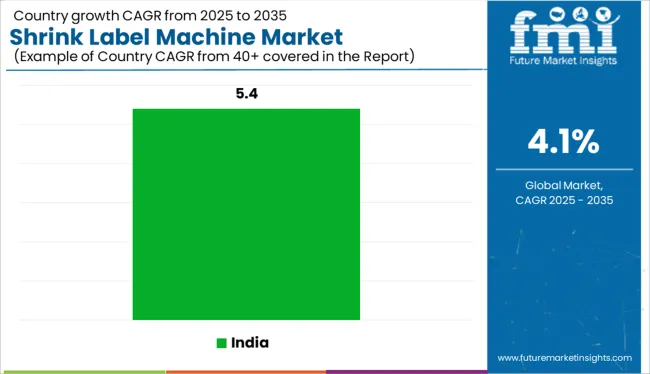
India’s shrink-label machine machines market is expected to register a CAGR of 5.4% during the forecast period. A developing country like India has done a tremendous job in 2024 by increasing exports by about USD 2.5 million worldwide, according to facts released by the Ministry of Pharmaceutical Sciences.
India ranks third in pharmaceutical production. Over the last decade, India has grown steadily at a CAGR of 9.4%. India shipped medicines to 120 countries during the pandemic. Eight of the 20 generic drug companies in the world are from India. Overall, the growing pharmaceutical company in India is the major factor augmenting the sales of shrink-label machine machines in India.
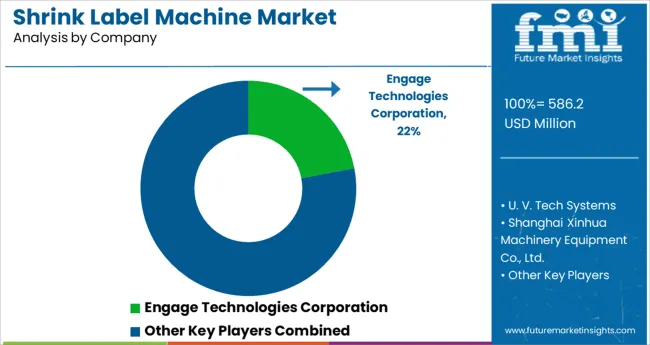
The key players operating in the shrink-label machine market are trying to focus on increasing their sales and revenues by expanding their capabilities to meet the growing demand.
The key players are trying to adopt a merger & acquisition strategy to expand their resources and are developing new technologies to meet customer needs. Also, the players are focusing on upgrading their facilities to cater to the demand. Some of the recent key developments by the leading players are as follows -
| Attribute | Details |
|---|---|
| Growth Rate | CAGR of 4.1% from 2025 to 2035 |
| Base Year for Estimation | 2025 |
| Historical Data | 2020 to 2025 |
| Forecast Period | 2025 to 2035 |
| Quantitative Units | Revenue in million, Volume in Units, and CAGR from 2025 to 2035 |
| Report Coverage | Revenue Forecast, Volume Forecast, Company Ranking, Competitive Landscape, Growth Factors, Trends, and Pricing Analysis |
| Segments Covered | Automation, Labelling Speed, End Use, Region |
| Regions Covered | North America; Latin America; Europe; East Asia; South Asia; Middle East and Africa; Oceania |
| Key Countries Covered | United States of America, Canada, Mexico, Brazil, Germany, United Kingdom, France, Italy, Spain, Russia, China, Japan, India, GCC countries, Australia |
| Key Companies Profiled | Engage Technologies Corporation; U. V. Tech Systems; Shanghai Xinhua Machinery Equipment Co., Ltd.; CHLB Packing Machine Co., Ltd.; KWT Machine Systems CO., LTD.; Shandong Sapphire Packaging Machinery Co., Ltd.; Dongguan Zhenying Machinery; Fuji Seal; Celtheq Industries Inc.; PDC International Corp.; Sleeve Seal; Multi Pack; SA Packaging Machinery; Super Packaging; Allen Pack |
| Customization & Pricing | Available upon Request |
The global shrink label machine market is estimated to be valued at USD 586.2 million in 2025.
It is projected to reach USD 876.0 million by 2035.
The market is expected to grow at a 4.1% CAGR between 2025 and 2035.
The key product types are automatic and semi-automatic.
200 bpm to 400 bpm segment is expected to dominate with a 38.0% industry share in 2025.






Our Research Products

The "Full Research Suite" delivers actionable market intel, deep dives on markets or technologies, so clients act faster, cut risk, and unlock growth.

The Leaderboard benchmarks and ranks top vendors, classifying them as Established Leaders, Leading Challengers, or Disruptors & Challengers.

Locates where complements amplify value and substitutes erode it, forecasting net impact by horizon

We deliver granular, decision-grade intel: market sizing, 5-year forecasts, pricing, adoption, usage, revenue, and operational KPIs—plus competitor tracking, regulation, and value chains—across 60 countries broadly.

Spot the shifts before they hit your P&L. We track inflection points, adoption curves, pricing moves, and ecosystem plays to show where demand is heading, why it is changing, and what to do next across high-growth markets and disruptive tech

Real-time reads of user behavior. We track shifting priorities, perceptions of today’s and next-gen services, and provider experience, then pace how fast tech moves from trial to adoption, blending buyer, consumer, and channel inputs with social signals (#WhySwitch, #UX).

Partner with our analyst team to build a custom report designed around your business priorities. From analysing market trends to assessing competitors or crafting bespoke datasets, we tailor insights to your needs.
Supplier Intelligence
Discovery & Profiling
Capacity & Footprint
Performance & Risk
Compliance & Governance
Commercial Readiness
Who Supplies Whom
Scorecards & Shortlists
Playbooks & Docs
Category Intelligence
Definition & Scope
Demand & Use Cases
Cost Drivers
Market Structure
Supply Chain Map
Trade & Policy
Operating Norms
Deliverables
Buyer Intelligence
Account Basics
Spend & Scope
Procurement Model
Vendor Requirements
Terms & Policies
Entry Strategy
Pain Points & Triggers
Outputs
Pricing Analysis
Benchmarks
Trends
Should-Cost
Indexation
Landed Cost
Commercial Terms
Deliverables
Brand Analysis
Positioning & Value Prop
Share & Presence
Customer Evidence
Go-to-Market
Digital & Reputation
Compliance & Trust
KPIs & Gaps
Outputs
Full Research Suite comprises of:
Market outlook & trends analysis
Interviews & case studies
Strategic recommendations
Vendor profiles & capabilities analysis
5-year forecasts
8 regions and 60+ country-level data splits
Market segment data splits
12 months of continuous data updates
DELIVERED AS:
PDF EXCEL ONLINE
Analyzing Shrink Label Machine Market Share & Industry Leaders
Shrink Sleeve Labeling Machine Size and Share Forecast Outlook 2025 to 2035
Labelling Machine Market Growth & Industry Trends through 2035
Shrink Sleeve Label Applicator Market Size and Share Forecast Outlook 2025 to 2035
Shrink Tunnel Machine Market Analysis - Size, Share, and Forecast Outlook 2025 to 2035
Market Share Distribution Among Shrink Sleeve Labels Providers
Industry Share Analysis for Shrink Sleeve Label Applicator Manufacturers
Shrink Sleeve Labels Market Analysis by Flexographic and Digital Printing Through 2034
Shrink Sleeve Labeling Equipment Market
Ops Shrink Label Market Size and Share Forecast Outlook 2025 to 2035
Shrink Wrapping Machines Market Size and Share Forecast Outlook 2025 to 2035
Market Share Insights for Shrink Wrapping Machines Providers
Shrink Bundling Machine Market Trends & Forecast 2024-2034
Shrink Wrapping Machine Market
Slide Labeling Machine Market Size and Share Forecast Outlook 2025 to 2035
C Wrap Labelling Machine Market
Heat Shrink Fitting Machines Market Size and Share Forecast Outlook 2025 to 2035
Shrink - Sleeve Wrapping Machinery Market Size and Share Forecast Outlook 2025 to 2035
Barcode Labeller Machine Market
Wet Glue Labelling Machines Market

Thank you!
You will receive an email from our Business Development Manager. Please be sure to check your SPAM/JUNK folder too.
Chat With
MaRIA